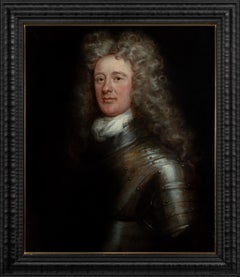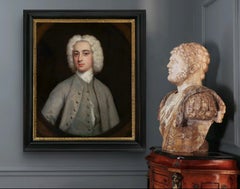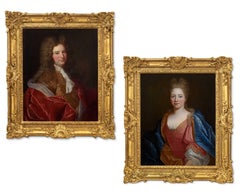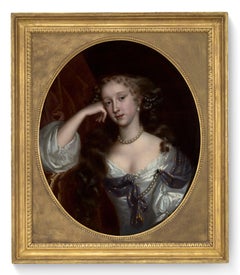Want more images or videos?
Request additional images or videos from the seller
1 of 11
Portrait of Frances Lady Whitmore nee Brooke, Exquisite Carved Frame, Peter Lely17th Century
17th Century
$18,036.55List Price
About the Item
- Creation Year:17th Century
- Dimensions:Height: 59.06 in (150 cm)Width: 49.22 in (125 cm)Depth: 2.37 in (6 cm)
- Medium:
- Movement & Style:
- Circle Of:Sir Peter Lely (1618 - 1680, Dutch)
- Period:
- Condition:This painting has passed a strict quality and condition assessment by a professional conservator prior to going on sale. It can be hung and enjoyed immediately.
- Gallery Location:London, GB
- Reference Number:1stDibs: LU1199114370432
About the Seller
5.0
Vetted Professional Seller
Every seller passes strict standards for authenticity and reliability
Established in 1998
1stDibs seller since 2019
45 sales on 1stDibs
Typical response time: 1 hour
Authenticity Guarantee
In the unlikely event there�’s an issue with an item’s authenticity, contact us within 1 year for a full refund. DetailsMoney-Back Guarantee
If your item is not as described, is damaged in transit, or does not arrive, contact us within 7 days for a full refund. Details24-Hour Cancellation
You have a 24-hour grace period in which to reconsider your purchase, with no questions asked.Vetted Professional Sellers
Our world-class sellers must adhere to strict standards for service and quality, maintaining the integrity of our listings.Price-Match Guarantee
If you find that a seller listed the same item for a lower price elsewhere, we’ll match it.Trusted Global Delivery
Our best-in-class carrier network provides specialized shipping options worldwide, including custom delivery.You May Also Like
Oil Portrait of a Victorian Lady, c. 1850
Located in Chicago, IL
Painted in the 19th century, this exquisite miniature portrait wonderfully exemplifies realism in traditional oil painting. The small artwork is painted in the conventional portraiture style of the Old Masters, and achieves soft realism with fine brushwork and a subdued, neutral palette. The half length portrait depicts a fine Victorian woman dressed in all black with a delicate lace collar and bonnet. She wears a ruby broach...
Category
Mid-19th Century Old Masters More Art
Materials
Oil
Robert K. White "Kelly Slater" Oil on Canvas, Realist Portrait of Surf Legend
Located in Miami, FL
ROBERT KENNETH WHITE – "KELLY SLATER"
Oil on Canvas ⚜ Hand Signed Lower Right ⚜ Frameless Display
A PORTRAIT OF FOCUS, LEGACY, AND DEPTH
Rendered with near-photographic precision, ...
Category
2010s Realist Portrait Paintings
Materials
Oil, Canvas
$6,200 Sale Price
38% Off
H 40 in W 28 in D 0.875 in
Robert K. White "Girl with Red Hair" Signed Oil, Contemporary Realist Portrait
Located in Miami, FL
ROBERT KENNETH WHITE – "GIRL WITH RED HAIR"
Oil on Canvas ⚜ Hand Signed Lower Right ⚜ Frameless Display
A PORTRAIT STUDY OF STRENGTH AND INTROSPECTION
In this emotionally charged p...
Category
2010s Realist Portrait Paintings
Materials
Oil, Canvas
$3,600 Sale Price
40% Off
H 24 in W 20.125 in D 0.875 in
"Army of Snorkelers" - Mirrored Female Swimmer Portrait Painting
Located in West Hollywood, CA
This large horizontal 37 inch high and 76 inch wide original oil painting on canvas is wired and ready to hang. The detail in this artwork is astounding. The crimson red tones make t...
Category
2010s Contemporary Portrait Paintings
Materials
Canvas, Oil
$6,000
H 37 in W 76 in D 1.5 in
"The Shining 2" - Colorful Female Figurative Swimmer Portrait Painting
Located in West Hollywood, CA
This 36 inch square original oil painting on canvas is wired and ready to hang. The detail in this artwork is astounding. The crimson red tones make the female swimmers portrait real...
Category
2010s Contemporary Portrait Paintings
Materials
Canvas, Oil
$4,000
H 36 in W 36 in D 1.5 in
"Christian (Brother)" Haitian Boy Portrait in Yellow Shirt
Located in Philadelphia, PA
This piece titled "Christian (Brother)" is an original artwork by Alain Jean-Baptiste and measures 60"h x 48"w. This oil work on canvas reflects on the buildup and aftermath Jean-B...
Category
21st Century and Contemporary Contemporary Portrait Paintings
Materials
Oil, Canvas
$5,000
H 60 in W 48 in
European Portrait of a Priest
Located in Milford, NH
A fine European portrait of a priest, oil on canvas, probably dating to the 17th or 18th century, unsigned, with original stretcher, minor surface losses and damage, craquelure, edge...
Category
17th Century Portrait Paintings
Materials
Canvas, Oil
Brown Eyed Girl + Blue Eyed Girl -2 Original Paintings On Canvas
By Andrea Stajan-Ferkul
Located in Mississauga, Ontario
With attention to detail, this delightful pair of paintings on canvas highlight the eyes, making them a focal point of each piece. The blending of acrylic paint, pencil and coloured ...
Category
2010s Contemporary Portrait Paintings
Materials
Canvas, Acrylic, Pencil, Color Pencil
$1,200
H 4 in W 4 in D 1.5 in
Blue Eyed Girl + Brown Eyed Girl -2 Original Paintings On Canvas, 4"x4" Each
By Andrea Stajan-Ferkul
Located in Mississauga, Ontario
With attention to detail, this delightful pair of paintings on canvas highlight the eyes, making them a focal point of each piece. The blending of acrylic paint, pencil and coloured ...
Category
2010s Contemporary Portrait Paintings
Materials
Canvas, Acrylic, Pencil, Color Pencil
$1,200
H 4 in W 4 in D 1.5 in
Blue Eyed Girl - 4"x4", Original Painting On Canvas, Small Portrait, Blonde
By Andrea Stajan-Ferkul
Located in Mississauga, Ontario
With attention to detail, this delightfully delicate painting on canvas places focus on the blue eyes which have a way of drawing you in. The portrait blends acrylic paint and colour...
Category
2010s Contemporary Portrait Paintings
Materials
Canvas, Acrylic, Pencil, Color Pencil
$650
H 4 in W 4 in D 1.5 in
More From This Seller
View AllPortrait of a Gentleman, David Erskine, 13th Laird of Dun, Wearing Armour c.1700
Located in London, GB
The gentleman in this exquisite oil on canvas portrait, presented by Titan Fine Art, is shown with the grandiloquence characteristic of the English School of painting. He is portray...
Category
17th Century Old Masters Portrait Paintings
Materials
Oil, Canvas
Portrait of a Gentleman in Grey Coat & White Cravat, Oil on canvas Painting
Located in London, GB
This exquisite work, presented by Titan Fine Art, is by the notable artist Hans Hysing, who was a noteworthy painter in England; it is significant in its q...
Category
18th Century Old Masters Portrait Paintings
Materials
Canvas, Oil
Portrait of a Lady and Portrait of Gentleman, Velvet & Silk Attire c.1700 French
By Nicolas de Largillière
Located in London, GB
These lavish portraits, presented by Titan Fine Art, illustrate the elegant and exuberant type of portrait that the French court and the bourgeoisie favoured at the end of the 17th century. Painted circa 1700, they combine a meticulous representation of the subject's face and rich detailed draperies. They are a mastery of colour and of a style perfected by the prestigious painter and Director of the Académie Royale de Peinture et de Sculpture in Paris, Nicolas de Largilliere.
France during this period was the leading exponent of fashion and the arts to the rest of Europe and the fashions arose from the French court itself – and this is evident in the clothing on display in these portraits. The gentleman has been depicted in a russet coat with golden thread embroidery, a white lace cravat, and a rich crimson velvet mantle, that has been deliberately turned over at the top to reveal its purple shot silk lining. The young beautiful lady, whose face is painted with a clear and fresh palette, wears a dress with golden embroidery on the bodice and a huge black diamond brooch, large balloon-like gathered sleeves with lace and tied with a string of pearls, and a luxurious azure blue velvet mantle, tied at the shoulder with a pearl and large diamond brooch, again, deliberately folded to reveal its real gold embroidered lining. Her cheeks are rosy, with red lips: a style in keeping with that was worn at Versailles. The copious number of expensive fabrics, that completely encircle them, serve to underline their social status.
The skilful works, with their beautiful colour combinations, create a strong visual impact. The artist demonstrates great skill in the rendering of sumptuous fabrics, the use of vibrant colours, and the realism of the faces.
The couple are most likely married, considering the conventions of portraiture at the time, where the male is positioned on the left (and inclined to our right) and the female is positioned on the right (and included to our left).
A feature of these portraits are the stunning original carved and gilded frames – they are works of art in their own right.
Nicolas de Largillierre was baptised in Paris in 1656. His family relocated to Antwerp when he was approximately three years old. After a journey to London, Largillière's father arranged for him to apprentice with the Flemish artist Anton Goubau. Nevertheless, he departed at the age of eighteen and returned to England, where he formed a friendship and was employed by Sir Peter Lely for four years in Windsor, Berkshire. During this period, Largillière also worked under the guidance of the Italian painter Antonio Verrio.
His artwork garnered the interest of Charles II, who desired to keep Largillière in his service; however, he eventually returned to Paris, where he was warmly embraced by the public as a painter.
Upon his ascension to the throne in 1685, James II summoned Largillière back to England and offered him the position of keeper of the royal collections. He subsequently painted portraits of the king, Queen Mary of Modena...
Category
17th Century Old Masters Portrait Paintings
Materials
Canvas, Oil
Portrait of a Lady, Elizabeth Fane, Countess Westmoreland in Silver Dress, oil
By John Michael Wright
Located in London, GB
Portrait of a Lady, Elizabeth Fane, Countess Westmoreland in Silver Dress c.1667
Circle of John Michael Wright (1617-94)
In this touching composition, painted around the time of Lon...
Category
17th Century Old Masters Portrait Paintings
Materials
Cotton Canvas, Oil
Portrait of Gentleman Blue & Cloak, Portrait of Lady, Fine Carved Gilded frames
Located in London, GB
Portrait of a Gentleman with Blue Cloak and Portrait of a Lady in Russet Dress c.1697
Thomas Murray (1663-1735)
These fascinating portraits are exquisite examples of portraiture in ...
Category
17th Century Old Masters Portrait Paintings
Materials
Oil, Canvas
Portrait Gentleman Armour, Blue Cloak, Diamond Brooch c.1700 French Carved Frame
By Joseph Vivien
Located in London, GB
Portrait of a Gentleman in Armour and Azure Cloak with Diamond Brooch c.1700
Attributed to Joseph Vivienne (1657-1735)
The sitter in this superb portrait, offered by Titan Fine Art...
Category
17th Century Old Masters Portrait Paintings
Materials
Oil, Cotton Canvas
Recently Viewed
View AllMore Ways To Browse
Lord Of The Rings Paintings
Van Dyke Antique
Circle Of Sir Godfrey Kneller
1860 Oil Painting Of Woman In Black Dress
Circle Of Peter Lely
Miniature Oil Portrait
Oil Painting Of Rabbi
Beautiful Black Woman
Duchess Of Marlborough
English Civil War
Lady Jane
Lady With A Fan
Native American Indian Paintings
Oil Portrait Officer
Oil Portraits Of Handsome Young Man
Painting Of A Salon
Portrait Of Maurice
Rembrandt Oil Painting



